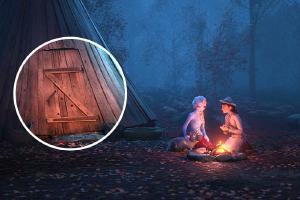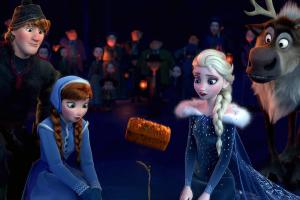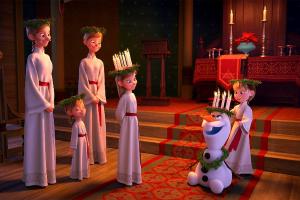Estimation of the year when Olaf's Frozen adventure took place

A Lunar calendar is a calendar based on the monthly cycles of the moon’s phase. If we had a full moon today, it becomes the third quarter about next week and the new moon next week. Also, if we are given a specific date, we can calculate which moon phase it would be. For example, we had a full moon on Oct. 20, 2021.
Conversely, if we were given a picture of a full moon and knew which month it was taken, we can estimate the specific date when the picture was taken. For instance, if we have a picture of the full moon phase and know that this picture was taken on Oct. 2021, since the full moon phase occurs near Oct. 20, we can say that this picture was taken at that time.
In this article, we estimate the year when Olaf’s Frozen adventure (or Frozen 1) took place by utilizing this information on the moon phase.
Method
Note that Olaf’s Frozen adventure (OFA) and Frozen 1 happen in the same year. I also think you guys agree that OFA took place on December. In this article, I will employ the argument that OFA took place on the winter solstice as discussed in the previous article. It is also quite well agreed that the Frozen took place in the 19th century. Thus, we can analyze the moon phase in this century and compare which year matches well to the moon phase seen in the film.
Frozen adventure
First, let’s examine the moon phase in OFA.

We can see the full moon in the night when Elsa, Anna, and other villagers are searching for Olaf in the forest. As mentioned before, this day is winter solstice. That is, this day seems to be winter solstice with full moon on the sky.

In the film, we can also find the scene where young Elsa looks outside through the window in her room. The thing is, we can also spot the full moon in the sky.
Since Anna gives Elsa the present(Olaf) on this day, this day seems to be the starting day of the winter holiday season as OFA.
Then, how old was Elsa in this scene? We can use Anna’s height to estimate it.

We can see young Anna in front of the door of Elsa’s room both on OFA and Frozen1, and we clearly see that the height of Anna in both scenes looks the same. Since a child grows day by day, we could estimate that these two events occurred in the same year as Anna is 5 years old. So, we can conclude that these two event took place on the same year with Anna being 5 and Elsa being 8 years old.

The above two events have a gap of 13 years. Thus, we need to find (1) two solstice days with (2) full moon phase having (3) 13 years gap.
We have the two most plausible candidates for the comparison.
- 1826 - 1839 hypothesis
- 1831 - 1844 hypothesis
The first hypothesis is based on the number written on the map in Frozen: Fever, and it argues that Frozen 1 took place on 1839. The second hypothesis is based on map data from Frozen 2 and some other facts and argues that Frozen 1 took place on 1844, and personally, I support this idea. See the previous article which discuss this subject.
Then, let’s test these hypotheses one by one.
Hypothesis 1 - 1839
This case assumes that OFA (or Frozen 1) happened in 1839. Let’s see how the moon phase changes in Dec. 1839.

The above figure shows the moon phase in December 1839. We have the first quarter on Dec. 13, full moon on Dec. 20, and the third quarter on 27. The winter solstice this year happened on Dec. 22 .
You might argue that there exists a 2-days difference between the day of the full moon phase and the winter solstice, but having this difference does not change the moon phase a lot.

The above figure is the actual moon phase before the full moon phase taken from NASA. You can verify that the moon’s shape before 2~3 days of the full moon phase does not change a lot. Furthermore, these pictures are taken from a delicate camera rather than crude eyes, so our eyes do not distinguish these phases quite well.
Even if the full moon phase occurs on Dec. 20 and the winter solstice on Dec. 22, with a 2-days difference, the moon’s shape will look almost the same. Thus, if we assume that OFA (of Frozen 1) happened in 1839, we can see the full moon-like shape on the day of the winter solstice. So, we don’t have any contradiction at this stage.
Hypothesis 1 - 1826
Now we analyze 1826, 13 years ago from 1839.

This year, we have the first quarter on Dec. 6, the full moon on Dec. 14, and the third quarter on Dec. 22. The problem is that the winter solstice also occurs on Dec. 22. We have the third quarter on the exact day of winter solstice. This means that we should observe the third quarter through the window of Elsa’s room, not the full moon, which induces the contradiction.
In other words, if we assume OFA (or Frozen 1) happened in 1839, we should not observe the full moon on the winter solstice in 1826. So, this hypothesis seems not to be working correctly.
Now, let’s consider the second hypothesis.
Hypothesis 2 - 1844
The second hypothesis assumes 1844 for Frozen 1 and 1831 for 13 years ago. First, let’s look at the moon phase of Dec. 1844.

For Dec. 1844, we see the first quarter on Dec. 16, the full moon on , Dec. 24 , and the third quarter on the Jan. 1 next year. The winter solstice occurs on Dec. 21 , but as we can see in the picture, the moon on this day looks almost the same as the full moon.
Hypothesis 2 - 1831
Then let’s consider 1831, 13 years ago from 1844.

In 1831, we had the first quarter on Dec. 12, the full moon on Dec. 19 , and the third quarter on Dec. 26. In this case, the winter solstice occurs on Dec. 22 . As discussed before, the moon’s shape 3 days after full moon day looks almost the same.
Thus, the second hypothesis assuming the two events happened on 1831 and 1844 shows no contradiction as in the first hypothesis. So if we simply try to match these two days of winter solstice with the full moon phase to the actual moon phase, the second hypothesis assuming Frozen 1 as 1844 seems more compatible than 1839.
Summary

It would be plausible to say that Frozen 1 (or Olaf’s Frozen adventure) took place in 1844 if we analyze the moon phases seen in Olaf’s Frozen adventure.



